
Styling with the CSS box-shadow property
Styling with the CSS box-shadow property 관련

The box-shadow CSS property allows you to add shadows to elements, giving you control over their size, blur, spread, and color. This feature enhances depth and visual emphasis, making it a popular choice for styling buttons, cards, and other UI components to improve both aesthetics and usability.

In this article, we’ll take a deep dive into the box-shadow property. We’ll start with a detailed breakdown of its syntax before exploring advanced techniques such as layered, neon, and neumorphic shadows. Additionally, we’ll provide a browser compatibility table, practical examples, and an interactive box-shadow generator to help you apply these styles effectively.
Update history
- 19 February 2025: Updated by Abiola Farounbi to add detailed syntax definitions, a browser compatibility table, visual CSS shadow examples, and an inline box-shadow generator tool
- 4 November 2024: Updated by Rahul Chhoddeto address recent CSS developments that impact the use of the
box-shadowproperty, including the View Transitions API, native CSS nesting, and the CSS@layerrule
The syntax
box-shadow: <x-offset> <y-offset> <blur-radius> <spread-radius> <shadow-color>;
| Property | Description |
|---|---|
x-offset | Sets the horizontal position of the shadow. Positive moves right, negative moves left. |
y-offset | Sets the vertical position of the shadow. Positive moves down, negative moves up. |
blur-radius | Defines the softness of the shadow. Higher values create more diffuse shadows. |
spread-radius | Determines shadow size. Positive values expand, negative values shrink. |
color | Specifies the shadow color in HEX, rgba(), or hsla(). |
Example
.card-1 {
box-shadow: 0px 5px 10px 0px rgba(0, 0, 0, 0.5);
}
.card-2 {
box-shadow: 0px -5px 10px 0px rgba(0, 0, 0, 0.5);
}
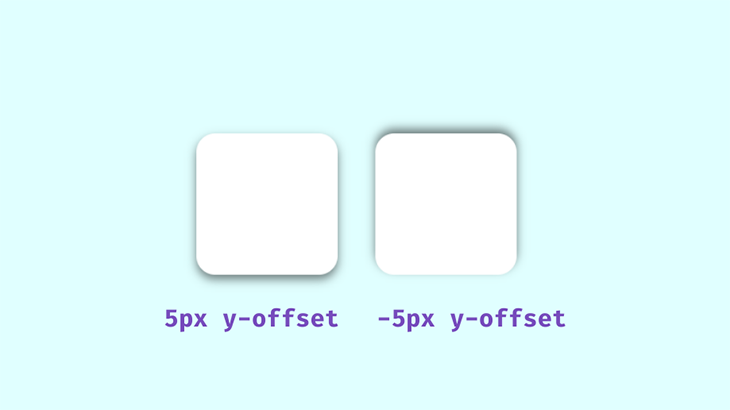
y-offset valuesWe’ll frequently use rgba() colors due to their alpha value, which allows for opacity control — an essential factor in creating realistic shadows. In well-lit environments, shadows aren’t purely black; instead, they adopt subtle hues influenced by surrounding light.
When styling with the box-shadow property, transparent shadows work best, as they blend seamlessly with multicolored backgrounds. Pay attention to how real-world shadows interact with their light sources — this observation will help you craft more natural-looking effects in CSS:
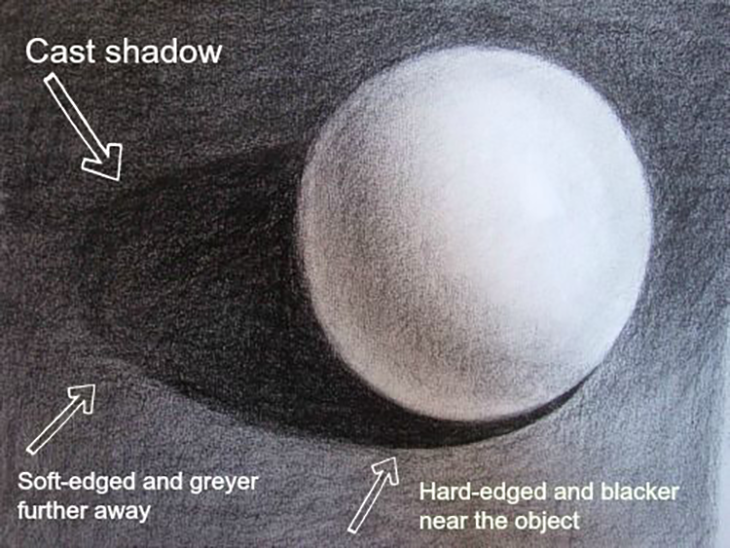
The area closest to the object has the darkest shadows, then it spreads and blurs outward gradually. Opaque or completely black shadows would be distracting, ugly, and imply a complete blockage of light, which isn’t what we’re after.
box-shadow vs. drop-shadow()
The drop-shadow() function applies shadows to images while respecting transparency, whereas box-shadow applies to the entire bounding box of an element. Here’s a visual comparison:
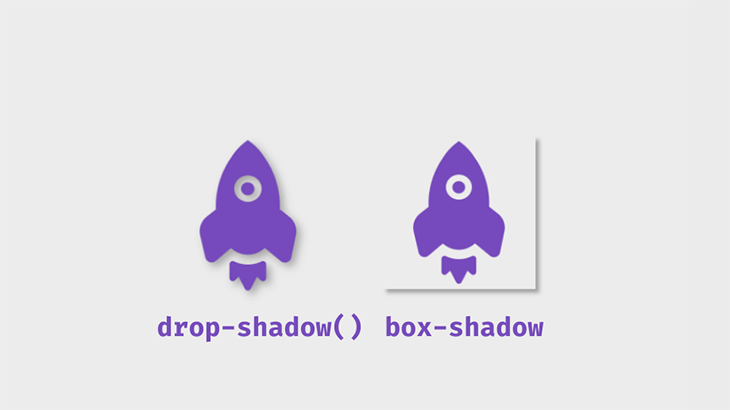
Example code:
.box-shadow {
box-shadow: 5px 5px 5px 0px rgba(0,0,0,0.3);
}
.shadow-filter {
filter: drop-shadow(5px 5px 5px rgba(0,0,0,0.3));
}
When to use box-shadow
Use box-shadow for UI elements like cards and buttons, and drop-shadow() for images or elements with transparency, ensuring the shadow follows their shape.
The following table outlines the key differences between box-shadow and drop-shadow():
ƒ
| Feature | box-shadow | drop-shadow() |
|---|---|---|
| Works on | Any block-level element | Images and elements with transparency |
| Follows transparency? | ❌ No, applies to the entire box | ✅ Yes, follows the element’s shape |
| Customizable blur & spread? | ✅ Yes | ❌ No |
| Best for | UI elements like buttons and cards | PNGs, SVGs, and transparent images |
While drop-shadow() is ideal for non-rectangular images, box-shadow provides more flexibility for UI elements. If you need shadows that adapt to transparent areas, drop-shadow() is the better option.
Getting started with box-shadow
First, create a simple box container with HTML:
<div class="box">
...
</div>
Next, apply the box-shadow property in CSS:
.box {
height: 150px;
width: 150px;
background: #fff;
border-radius: 20px;
box-shadow: 0px 5px 10px 0px rgba(0, 0, 0, 0.5);
}
This will render a simple box with a shadow:
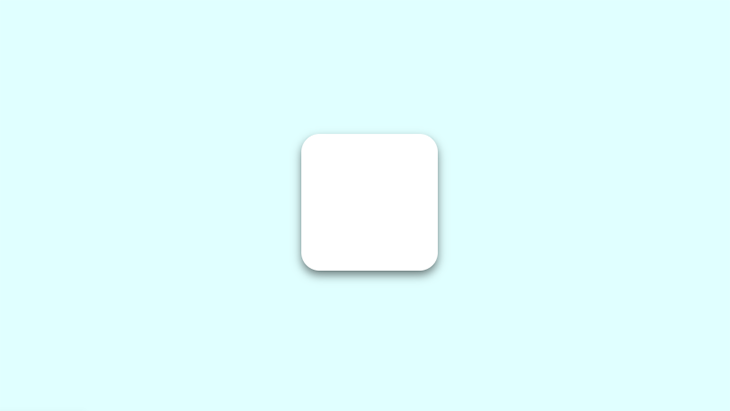
Experiment with an interactive box-shadow generator
Try adjusting the values below using our interactive box-shadow generator. Modify parameters such as x-offset, y-offset, blur, and spread to see real-time changes. Once satisfied, copy the generated CSS for immediate use in your projects:
CSS box-shadow use cases
Using box-shadow with the :hover pseudo-class and transform property
The box-shadow property can be dynamically modified using the :hover pseudo-class. You can add a shadow to an element that previously had none or adjust an existing shadow. In this example, the transform property enhances the illusion of depth:
.box:hover {
box-shadow: 0px 10px 20px 5px rgba(0, 0, 0, 0.5);
transform: translateY(-5px);
}
The transform property makes it appear as though the box is lifting off the page. Conversely, using the inset keyword places the shadow inside the element’s frame, giving the effect of it sinking into the page:
.box2 {
box-shadow: inset 0px 5px 10px 0px rgba(0, 0, 0, 0.5);
}
.box2:hover {
transform: translateY(5px);
box-shadow: inset 0px 10px 20px 2px rgba(0, 0, 0, 0.25);
}
You can experiment with these values to achieve the desired effect. Here’s what these shadows look like:
An alternative to translate() is scale(), which increases the size of the element rather than repositioning it. In this example, the scale() function enlarges the box when hovered:
.box2:hover {
transform: scale(1.1);
box-shadow: 0px 10px 20px 2px rgba(0, 0, 0, 0.25);
}
This effect scales the box to 1.1 times its original size:
Combining the box-shadow property with text-shadow
Like box-shadow, the text-shadow property allows you to define a shadow’s blur radius, color, and offset. This property lets you create visual effects that enhance text readability and aesthetics. Here’s the basic syntax:
.selector {
text-shadow: <horizontal-offset> <vertical-offset> <blur-radius> <color>;
}
While text-shadow applies only to text elements, it can be combined with box-shadow to add depth and dimension to UI components. Here’s an example:
<div class="site-container">
<div class="card">...</p>
</div>
In this example, both box-shadow and text-shadow enhance the .card class. The two shadow layers create a neumorphic effect, while the text shadow adds contrast and visual appeal:
.card {
padding: 2rem;
border-radius: 0.5rem;
background: linear-gradient(145deg, #cacaca, #f0f0f0);
color: #764abc;
text-shadow:
-6px 6px 15px rgba(0, 0, 0, 0.5),
6px -6px 15px rgba(255, 255, 255, 0.8);
box-shadow:
20px 20px 60px #bebebe,
-20px -20px 60px white;
}
Here’s the result:
Creating layered shadows
You can stack multiple shadows by separating them with commas. This technique produces smooth, layered effects:
.stacked-shadows {
box-shadow: 0px 1px 2px rgba(0,0,0,0.1),
0px 2px 4px rgba(0,0,0,0.1),
0px 4px 8px rgba(0,0,0,0.1),
0px 8px 16px rgba(0,0,0,0.1);
}
Notice that the spread value isn’t included — it’s optional and depends on the desired effect. Alternatively, setting the offset and blur radius to 0px while adding a spread value creates a border-like shadow:
.bordered-stacked-shadows {
box-shadow: 0px 0px 0px 2px rgba(0,0,0,0.5),
0px 2px 4px rgba(0,0,0,0.1),
0px 4px 8px rgba(0,0,0,0.1),
0px 8px 16px rgba(0,0,0,0.1);
}
Since this border effect uses box-shadow, it doesn’t add extra space to the element’s parent container:
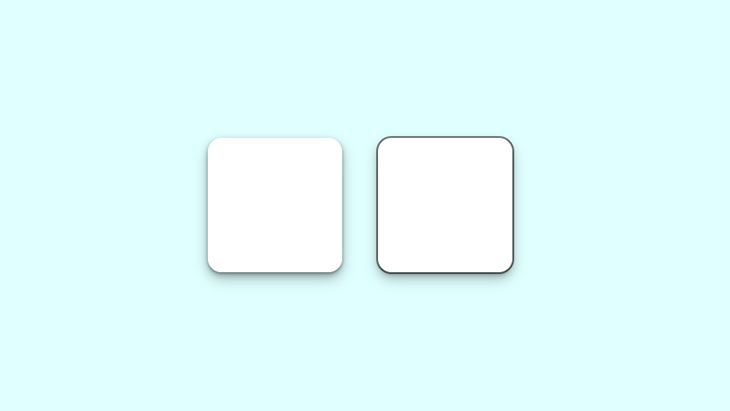
The left box features a smooth, layered shadow, while the right box has a defined shadow border.
Now, let’s look at the box-shadow in a practical scenario. This property can be used on almost any element on a webpage, but the more common ones include the navbar, text cards, and images. It can also be added to input fields and buttons:
Build a simple webpage like the one shown in the demo, and try styling the box-shadow yourself!
Creating neon shadows
In the real world, shadows are usually black or gray with varying opacity. But what if shadows had colors? Colored shadows occur when the light source itself is colored. Since there’s no real equivalent of a light source in CSS, you can achieve this neon effect by adjusting the color value in box-shadow.
Let’s modify our first example:
.box {
box-shadow: 0px 5px 10px 0px rgba(0, 0, 0, 0.7);
}
.box2 {
box-shadow: inset 0px 5px 10px 0px rgba(0, 0, 0, 0.7);
}
This is the output:
To create a more vibrant glow, you can layer multiple shadows:
box-shadow: 0px 1px 2px 0px rgba(0,255,255,0.7),
1px 2px 4px 0px rgba(0,255,255,0.7),
2px 4px 8px 0px rgba(0,255,255,0.7),
2px 4px 16px 0px rgba(0,255,255,0.7);
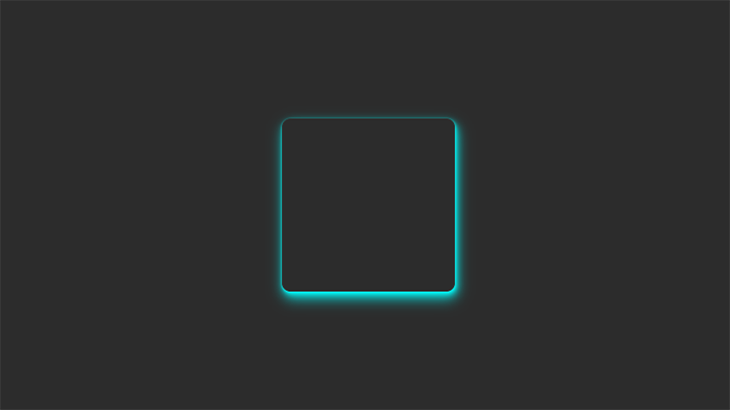
Neon shadows are best showcased on dark-themed web pages. Dark themes are widely popular, and when combined with contrasting colors, neon shadows can enhance the aesthetic.
To see this effect in action, we’ll adjust the earlier demo by darkening the background and experimenting with different shadow colors:
Using colors that contrast well—like the blue box-shadow against a dark background in this demo—ensures the effect is visually striking. Increasing the opacity makes the glow even brighter.
Creating neumorphic shadows
Neumorphism is a modern design trend derived from skeuomorphism, which replicates real-world objects in digital interfaces. This effect makes UI components appear to extrude from the background, creating a soft, three-dimensional look.
To achieve this, you can apply two opposite box-shadow values:
.neumorphic-shadow {
box-shadow:
-10px -10px 15px rgba(255,255,255,0.5),
10px 10px 15px rgba(70,70,70,0.12);
}
To create an inset effect, place the shadows inside the element:
.neumorphic-shadow {
box-shadow:
inset -10px -10px 15px rgba(255, 255, 255, 0.5),
inset 10px 10px 15px rgba(70, 70, 70, 0.12);
}

In the example above, two shadows work in opposite directions. The white box-shadow simulates the light source, acting as a highlight—similar to how light interacts with objects in real life:
Neumorphic design mimics real-world objects in a way that makes them feel tangible. Let’s take this a step further and create an interactive push switch using a checkbox:
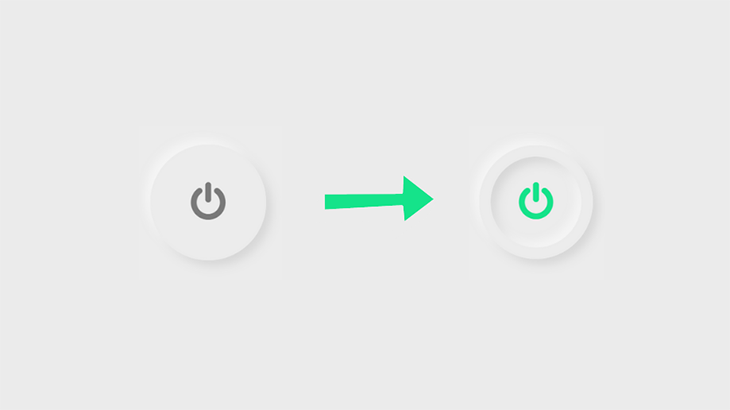
Step 1: Create the checkbox input
<input type="checkbox" class="neumorphic-checkbox" />
Step 2: Style the switch
.neumorphic-switch {
display: flex;
align-items: center;
justify-content: center;
height: 200px;
width: 200px;
border-radius: 50%;
box-shadow:
-10px -10px 15px rgba(255, 255, 255, 0.5),
10px 10px 15px rgba(70, 70, 70, 0.12);
border: 20px solid #ececec;
outline: none;
cursor: pointer;
-webkit-appearance: none;
}
Step 3: Add an icon
We’ll use Font Awesome for the power button icon. Link the CDN and add the icon’s Unicode:
.neumorphic-switch::after {
font-family: FontAwesome;
content: "\f011"; /*ON/OFF icon Unicode*/
color: #7a7a7a;
font-size: 70px;
}
Step 4: Define the active state
When clicked, the button will invert the shadow effect using two inset layers:
.neumorphic-switch:checked{
box-shadow:
-10px -10px 15px rgba(255, 255, 255, 0.5),
10px 10px 15px rgba(70, 70, 70, 0.12),
inset -10px -10px 15px rgba(255, 255, 255, 0.5),
inset 10px 10px 15px rgba(70, 70, 70, 0.12);
}
Finally, update the icon color when the switch is activated:
.neumorphic-switch:checked::after{
color: #15e38a;
}
Here’s the final result:
CSS box-shadow examples
There are many different ways to use box-shadow, depending on your design needs. Below is an interactive gallery showcasing various shadow styles along with their corresponding code snippets:
CSS box-shadow with the View Transitions API
With the View Transitions API, you can dynamically apply box-shadow styles for smooth element and page transitions. Let’s explore how this works with a simple example that focuses on same-document transitions.
Step 1: Define the base styles
We’ll start by defining styles for a card component that expands and collapses when clicked:
.card {
...
box-shadow: 0 0 0.25rem 0.5rem rgba(0, 0, 0, .15);
}
.card--collapsible {
height: 120px;
overflow: hidden;
view-transition-name: card;
}
.card--expanded {
height: auto;
box-shadow: 0 1rem 2rem rgba(0, 0, 0, .35);
}
Step 2: Toggle classes dynamically
Using JavaScript’s classList API, we can toggle the CSS class that controls box-shadow styles:
const card = document.querySelector(".card");
card?.addEventListener("click", () => {
card.classList.toggle("card--elevated");
});
This logic can be used inside the startViewTransitions method of the View Transitions API to enhance the effect:
As demonstrated in the demo, the View Transitions API applies a default cross-fading animation, making it appear as though the shadow itself is smoothly transitioning.
Alternative: Managing styles with JavaScript
If you prefer handling styles via JavaScript, you can use the boxShadow property:
const targetElement = document.querySelector(".my-element");
targetElement?.style.boxShadow = "0 0 3px 4px hsl(25deg 50% 50% / 20%)"
Note
Before implementing this in production, make sure to check the browser support for View Transtions, which is currently just above 74 percent.
CSS box-shadow with native CSS nesting
When managing complex box-shadow utilities, native CSS nesting helps reduce redundancy and improves maintainability.
For example, say you have a card component with different shadow styles for hover, active, and focus states. Instead of writing separate rules, you can use CSS nesting to simplify the structure:
/* Simple card */
.card {
/* Card styles */
box-shadow: ...;
&:hover {
box-shadow: ...;
}
&:active {
box-shadow: ...;
}
}
/* Elevated card variation */
.card--elevated {
/* Elevated card styles */
box-shadow: ...;
&:hover { ... }
&:active { ... }
}
This structure is easier to manage and maintain compared to separate rule sets. We can take this one step further with cascade layers, another important modern CSS feature covered in the next section.
CSS box-shadow in @layer blocks
The @layer rule in CSS helps control specificity issues and maintain cleaner styles. You can use it to structure box-shadow utilities in a more organized way.
Step 1: Define specificity order
The first line below establishes the specificity order, ensuring that utility styles override component styles:
@layer base, components, utilities;
Step 2: Define shadow variables in the base layer
@layer base {
:root {
--shadow-sm: 0 1px 2px rgba(0, 0, 0, 0.1);
--shadow-md: 0 1px 3px rgba(0, 0, 0, 0.15);
--shadow-lg: 0 4px 6px rgba(0, 0, 0, 0.2);
@media (prefers-color-scheme: dark) {
--shadow-sm: 0 1px 2px rgba(0, 0, 0, 0.2);
--shadow-md: 0 1px 3px rgba(0, 0, 0, 0.3);
--shadow-lg: 0 4px 6px rgba(0, 0, 0, 0.4);
}
}
}
Step 3: Apply box-shadow styles within component and utility layers
@layer components {
.card {
box-shadow: var(--shadow-md);
&:hover { box-shadow: var(--shadow-lg); }
&:active { box-shadow: var(--shadow-sm); }
}
}
@layer utilities {
.shadow-sm { box-shadow: var(--shadow-sm); }
.shadow-md { box-shadow: var(--shadow-md); }
.shadow-lg { box-shadow: var(--shadow-lg); }
}
Because utility styles are declared later in the specificity order, they automatically override component styles when necessary.
This layering strategy enhances maintainability, improves organization, and makes integrating styles with CSS frameworks much easier.
CSS box-shadow generator
We have explored various use cases for the CSS box-shadow property. If you want to go further and try out even more styles, you can experiment with this interactive box-shadow generator below:
Browser compatibility

According to Can I use, the box-shadow CSS property is fully supported across all modern browsers, including their latest released versions.
box-shadow best practices
The box-shadow property is a powerful way to enhance the visual appeal of your website, but improper use can negatively impact performance and design. Here are some best practices to keep in mind:
Important
- Less is more - When layering multiple shadows, the browser has to perform more rendering work. This may not be an issue on high-end devices, but users with older hardware or slow internet connections might experience lag
- Be consistent - Avoid using inconsistent shadow styles. Shadows should follow a single light source to maintain a cohesive and realistic design
- Use animations sparingly - Animating box-shadow can significantly impact performance. Since box-shadow already enhances UI elements, keep animations minimal, such as a subtle transition effect on :hover
- Use a shadow layering tool - Instead of manually writing multiple shadow values, use tools like shadows.brumm.af. This tool allows you to generate and adjust up to 10 box-shadow layers, making it easier to achieve complex and refined shadow effects
Conclusion
In this article, we explored various techniques for using the box-shadow CSS property, including:
- Layering shadows for enhanced depth
- Creating neon shadows for a glowing effect
- Implementing
box-shadowwith the View Transitions API, native CSS nesting, and cascade layers - Combining
box-shadowwithtext-shadowto create well-rounded visual effects
Now, you’re well on your way to mastering box-shadow! The best way to improve is through hands-on experimentation. Try using an inline box-shadow generator to see how many shadow layers you can stack, experiment with different color combinations, and test your designs across multiple devices to ensure optimal performance.